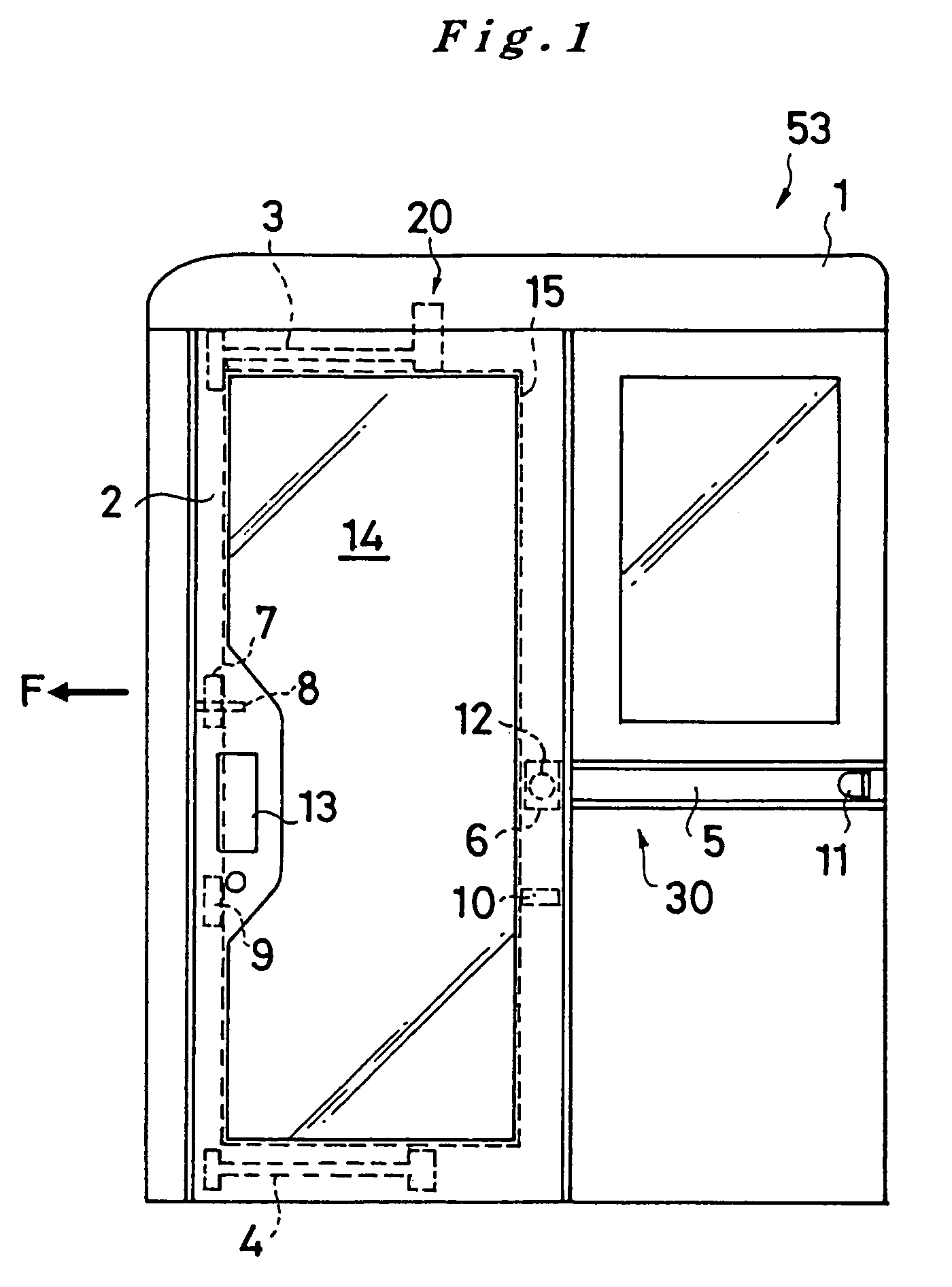Operator cab for construction machine
a technology for operating cabs and construction machines, which is applied to roofs, doors, wing accessories, etc., can solve the problems of the door in its opened condition exceeding the turning radius, and achieves the effects of high endurance, good door operation, and high water tightness
- Summary
- Abstract
- Description
- Claims
- Application Information
AI Technical Summary
Benefits of technology
Problems solved by technology
Method used
Image
Examples
first embodiment
(First Embodiment)
[0033]Now, the construction of a door 2 as a first embodiment, which is attached to the operator cab 53, is described in reference to FIG. 1˜FIG. 8. In the following description, the direction of the closing of the door is referred to as “forward” (arrow F in FIG. 1). As shown in FIG. 1, the door 2, whose front side is attached to the cab box 1 by a link mechanism 20 and whose rear side is attached to the cab box 1 by a slide mechanism 30, opens and closes an entrance 15 to the cab room 1a, which is defined by the cab box 1. The link mechanism 20 comprises an upper link member 3, which is located at the upper part of the door 2, and a lower link member 4, which is located at the lower part of the door 2. One end of each link member is connected pivotally to the cab box 1, and the other end is connected pivotally to the door 2, so that the link members can swing freely. On the other hand, the slide mechanism 30, which is positioned approximately at the vertical cent...
second embodiment
(Second Embodiment)
[0050]In the first embodiment, the front part of the door 2 is supported by the link mechanism 20 while the rear part is supported by the slide mechanism 30. However, it is possible that both the front and rear of the door be supported either by a link mechanism or by a slide mechanism alone, so each of such cases is described in the following, where components identical to those of the first embodiment are indicated by the same numerals to leave out redundant explanation.
[0051]At first, as a second embodiment, a case where both the front and rear parts of the door 2 are supported by a link mechanism 120 is described in reference to FIG. 11˜FIG. 13. The link mechanism 120 in the second embodiment comprises a front link member 103 and a rear link member 104, which are positioned, respectively, one in front of the other. One end (fixed end 103a or 104a) of each link member is connected pivotally to the cab box 1 at the upper part thereof, and the other end (moving e...
third embodiment
(Third Embodiment)
[0056]As a third embodiment, a case where both the front and rear parts of the door 2 are supported only by slide mechanisms 30, 230 and 240 is described in reference to FIG. 14˜FIG. 16. In the third embodiment, the upper front part of the door 2 is supported by the upper slide mechanism 230, the lower front part of the door 2 is supported by the lower slide mechanism 240, and the approximate, vertical center of the rear part of the door 2 is supported by the slide mechanism 30, which is the same as the first embodiment.
[0057]The upper slide mechanism 230 comprises an upper slide rail 203, which is attached on the cab box 1 along the upper side of the entrance of the cab box 1, and an upper slide member 303, which slides along the upper slide rail 203. The lower slide mechanism 240 comprises a lower slide rail 204, which is attached on the cab box 1 along the lower side of the entrance, and a lower slide member 304, which slides along the lower slide rail 204.
[0058...
PUM
 Login to View More
Login to View More Abstract
Description
Claims
Application Information
 Login to View More
Login to View More - R&D
- Intellectual Property
- Life Sciences
- Materials
- Tech Scout
- Unparalleled Data Quality
- Higher Quality Content
- 60% Fewer Hallucinations
Browse by: Latest US Patents, China's latest patents, Technical Efficacy Thesaurus, Application Domain, Technology Topic, Popular Technical Reports.
© 2025 PatSnap. All rights reserved.Legal|Privacy policy|Modern Slavery Act Transparency Statement|Sitemap|About US| Contact US: help@patsnap.com



